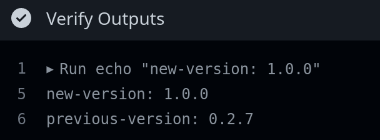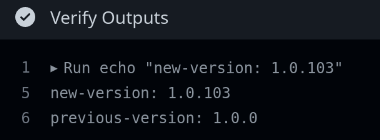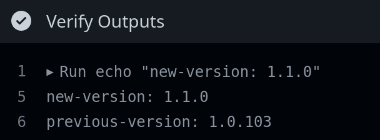Introduction
Language/content agnostic method of automatically determining the semantic version for a product based on branch merge history with MINIMAL discipline dependencies.
This is accomplished by counting the merges of branches matching the naming scheme into the [main|master] branch. Folks familiar with Scrum/SAFe or GitFlow/fooFlow strategies will recognize this scheme.
Yes, this can be implemented in repos that previously used different version increment methods.
NOTE: While this is a production hardened versioning kit, it's implementation as a GH action took a bit of fussing. Please test it and provide any feedback by opening an issue.
Usage
Setup
- Repository Setup
- 1. Disable squash merging in the repository settings.
- ?. If you have a previously established version for the repo, ensure it's tagged like: 'MAJOR.MINOR.PATCH'.
For example, if you have a tag like 'v1.2.3', you will want to add a tag like '1.2.3' to that commit as well, which might look like: git checkout v1.2.3 git tag 1.2.3 git push --tags
- Workflow Setup
- 2. Ensure your action executes a checkout step prior to using this action.
- 3. Use the outputs from this action as desired. For example, you might use it to update the version of an npm package:
npm version $NEW_VERSION
- 4. Tag the repo with the new version at some point in the workflow.
- Team Setup
- 5. Ensure the iteration team adheres to the branch naming scheme defined below. Here's an example workflow.
git checkout -b fix/not-a-feature git commit --allow-empty -m "This was a bug and not a feature after all..." git push --set-upstream origin fix/not-a-feature # THEN: Click the link to create a PR & merge it
Outputs
- new-version: [string]
- The newly detected version.
- previous-version: [string]
- The previous version.
Example GH Action Workflow
This is a valid workflow utilizing this action.
name: gitops-autover
on:
push:
branches:
- main
jobs:
use-action:
name: Verify GitOps AutoVer Action
runs-on: ubuntu-latest
steps:
- uses: actions/checkout@v3
- name: Run GitOps Automatic Versioning Action
id: gitops-autover
uses: AlexAtkinson/github-action-gitops-autover@0.1.7
- name: Verify Outputs
run: |
NEW_VERSION=${{ steps.gitops-autover.outputs.new-version }}
echo "new-version: $NEW_VERSION"
PREVIOUS_VERSION=${{ steps.gitops-autover.outputs.previous-version }}
echo "previous-version: $PREVIOUS_VERSION"
This results in outputs like:
major:
patch:
minor:
Q: How did you execute 103 merges?
A: You can use the bump scripts in the scripts directory of this
repo, like: './scripts/bumpPatch.sh 42'. (Does not work with branch protection enabled)
Additionally, this repo uses its own action for versioning, so feel free to investigate that workflow for another example.
Discipline Dependency
Branch Naming Scheme
This action depends only on the following branch naming scheme being observed.
| Branch Name | Increment | Description |
|---|---|---|
| feature/.* | Minor | Product features. |
| enhancement/.* | Minor | Product enhancements. |
| fix/.* | Patch | Product fixes |
| bugfix/.* | Patch | You should use fix. |
| hotfix/.* | Patch | Are you from the past? |
| ops/.* | Patch | Enables ops changes to trigger builds. |
For example, the name of the branch for a new awesome feature named Awesome Feature, might be: 'feature/awesome_feature'.
Appropriate Use Cases
This action is most suitable for git projects with the following operational design:
- Each merge into main|master is intended to produce an artifact, following the "everything is potentially releasabe" approach.
This action is not suitable for projects requiring pre-release, beta, etc., type fields. Such projects should depend upon their own language native tooling.
This action is not suitable for projects requiring version numbers to be planned and orchestrated ahead of time.
Version Format
Versions are returned only in the following format: 'MAJOR.MINOR.PATCH'.
Major Increments
MAJOR version increments depend upon manual intervention to trigger as it is not practical to automatically detect either major refactoring or accepted/planned breaking changes to a product. Human input informs the tool of such MAJOR increment qualifying scenarios.
This increment can be accomplished in one of the following ways:
-
Push a commit message containing: '+semver: [major|breaking]'. For example:
git commit --allow-empty -m "+semver: major" git push -
Push the MAJOR tag manually. That this is the less desirable option as it will require the merge of a qualifying branch to iterate the version number, making the first possible version that could be produced 'n.0.1'. Assuming successful build and testing.
git tag 1.0.0 git push --tags
Version Increment Logic
For those interested, here's some pseudo code:
lastMajor = Extract from previous git tag (why option 1 is recommended)
lastMinor = Extract from previous git tag
lastPatch = Extract from previous git tag
IF no previous git tag; THEN
MAJOR = 0
MINOR = 0
PATCH = 0
IF major increment indicator; THEN
MAJOR = lastMajor + 1
MINOR = 0
PATCH = 0
ELSEIF merged feature/.* or enhancement/.* branches; THEN
MAJOR = lastMajor
MINOR = lastMinor + count of merged branches
PATCH = 0
ELSEIF merged bugfix/.* or hotfix/.* branches; THEN
MAJOR = lastMajor
MINOR = lastMinor
PATCH = lastPatch + count of merged branches
[Known|Non]-Issues
-
If there are no merges of branches conforming to the above naming scheme, this action will fail with the following output:
ERROR: No feature, enhancement, fix, bugfix, hotfix, or ops branches detected!- When encountering this scenario, and a build is desired, you can simply create a branch with the appropriate naming convention and an empty commit, then merge it. Or use the bump scripts in the 'scripts/' directory of the repo for this action.
-
Merged branches not conforming to the above naming scheme will simply be ignored.
- HINT: This can be useful when you don't want to increment the version.
- Align this with build 'on:push:branches:' workflow configuration to avoid unnecessary builds.
- HINT: This can be useful when you don't want to increment the version.
-
The version output does not have a 'v' prefix.
-
If you would like a 'v' prefix to your versions, add it to your logic when using the output from this action. For example:
echo "The new version is v${{ steps.detect-version.outputs.new-version }}" ^ here
-
-
If both 'main' and 'master' branches exist remotely: FAIL
- This will not be changed.
-
Squash merging must be disabled. This is required to populate the git log with the commit messages issued from the git provider.
Future Enhancements
PRs are welcome.
- input(s): iteration-branches (map) - inform MINOR and PATCH incrementing branch name patterns.
- input(s): mono-mode (bool) - version subdirs discretely
CAN'T DO: DONE: unshallow from last version tag to latest commit to... Seems a limitation of (git at first glance). See the Checkout From Tag action.







